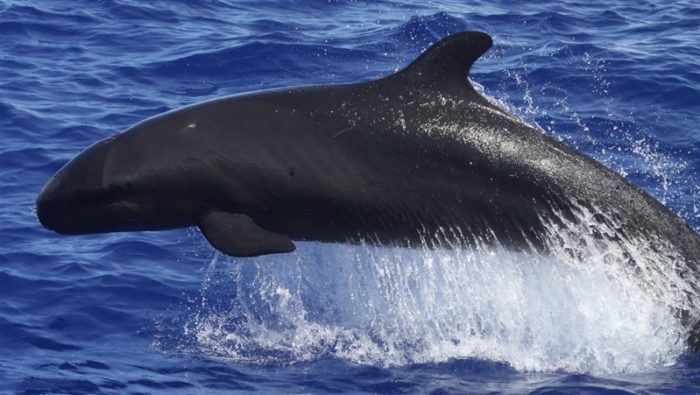
Sea Wonder: False Killer Whale

Photo Credit: Robin Baird
If the only part of this sea wonder’s body visible above water was the top of its head, you might guess you were seeing an orca or killer whale. That is exactly how the false killer whale (Pseudorca crassidens) got its name! While they are named after orcas, they actually look quite similar to pygmy killer whales and melon-headed whales, so much so that it is very difficult for even trained observers to tell them apart.
Description
Members of the dolphin family, false killer whales are solid black or dark grey in color with slightly lighter skin on the underside (ventral side) of their body. Their bodies are torpedo-like with a slender body and tapered head, adults can reach maximum lengths of nearly 20 feet and weigh as much as 5,000 pounds, and males and females are similar in size (though males have larger melons or foreheads). A single, sickle-shaped dorsal fin is located about halfway down their backs and on their sides are two curved pectoral fins. The blowhole atop their heads allows them to breathe while swimming and the 30 to 44 cone-shaped teeth in their mouths help them trap and keep hold of their prey.
Diet & Habitat
False killer whales are opportunistic feeders, which means they feed on whatever is available and easiest to catch. They are usually daytime hunters and commonly target squid and various species of fish like mahi-mahi or tuna. Occasionally, they will hunt other marine mammals like seals, smaller species of dolphins, and even larger animals like humpback whales and sperm whales. False killer whales hunt in cooperative groups and often share food among their pod.
This species inhabits deep, open-ocean waters around the world and is most commonly seen in tropical latitudes. This means you can find false killer whales in or near most of the oceanic sites within the National Marine Sanctuary System. Since observing and tracking these animals over time is difficult, experts still aren’t sure if false killer whales are migratory or stay within a particular home range.
Life History

Photo Credit: Marie Hill/ NOAA/NMFS/Pacific Islands Fisheries Science Center Blog 2013 07 30
False killer whales are highly social, forming stable groups and strong connections that last several years. They even socialize with other species of dolphins on occasion! Individual pods of false killer whales are comprised of 15 to 25 individuals on average, and groups often converge at hunting sites or during reproductive periods. Scientists believe their strong social bonds lead to mass stranding events – when one member of the group goes astray, the rest follow.
Individuals reach sexual maturity between 8 and 14 years of age and may live as long as 60 years. Mating usually happens in the late winter months but can occur anytime throughout the year as females can cycle into estrus when environmental conditions are just right and food is plentiful. Pregnancies last for about 15 months and calves nurse from their mothers for anywhere from nine months to two years. The time between births is estimated to be around 7 years.
Threats & Conservation
Populations of false killer whales are not all easy to monitor, but we do know that the International Union for Conservation of Nature (IUCN) lists the species as near threatened. One nearshore population of about 150 false killer whales in the Hawaiian Islands is listed as endangered under the United States’ Endangered Species Act of 1972 while a well-studied Hawaiian Island population that lives farther offshore is healthier, comprised of an estimated 1,500 individuals.
Threats to the species include overfishing that limits prey availability, climate change, ship strikes, and entanglement in fishing gear when these animals attempt to feed off of fishing lines or nets.

Photo Credit: Robin Baird
